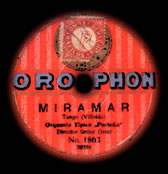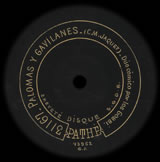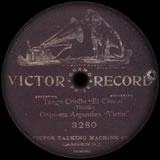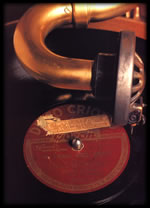By
At what speed the 78 rpm discs were recorded?

f the question is connected with the records published as from the late 20s, the answer is obvious: at 78 revolutions per minute. But the ones recorded previously and especially by the acoustic system may have been cut in the most different ways.
 In fact, worldwide recordings were made either at speeds close to 78 rpm or at very different speeds, faster or slower. For instance, the good discographies of the tenor Enrico Caruso warn us that the recordings must be heard, according to the time and place of the recording, between 73 and 80 rpm. Of course, such information is precisely indicated for each particular case, allowing the listener to perceive the tempo and the timbre really generated in the recording studio.
In fact, worldwide recordings were made either at speeds close to 78 rpm or at very different speeds, faster or slower. For instance, the good discographies of the tenor Enrico Caruso warn us that the recordings must be heard, according to the time and place of the recording, between 73 and 80 rpm. Of course, such information is precisely indicated for each particular case, allowing the listener to perceive the tempo and the timbre really generated in the recording studio.
The local recordings were not an exception to this reality. Later, the one who tries to make restorations with original discs, must have into account this fact. And we say with original discs because if magnetic tapes are used, recorded with machines different to the ones which would play them, the doubts about the real speed are increased. And as it usually happens, they are also copies of copies which went through the most different machines and hands. The anarchy is complete.
 However, there is a special feature in our criollo repertoire, whether its matrices came from abroad or were cut in our country. In fact, in the cases which deviate from the mythical 78 revolutions, differences below that value are usually perceived. But that would be the only uniformity that the problem poses because the variations are different for each record company. And for the cases of companies that lasted for decades, like Odeon and Victor, they even changed through time.
However, there is a special feature in our criollo repertoire, whether its matrices came from abroad or were cut in our country. In fact, in the cases which deviate from the mythical 78 revolutions, differences below that value are usually perceived. But that would be the only uniformity that the problem poses because the variations are different for each record company. And for the cases of companies that lasted for decades, like Odeon and Victor, they even changed through time.
Now a series of questions spring up: was it an aesthetic manipulation carried out by the recording companies?; why neither the public nor the artists complained about that situation?. The answer may be found either in the characteristics of the recording and playing machines or the powers of the recording technicians.
Beginning with the latter, we can say that until the early 20s they had an absolute, dictatorial control about how a recording had to me made. Their opinion could not be questioned, so the artists had to obey their plans. For example, their placement in front of the recording horns which generated the relative supremacy of the different instruments. And, of course, no one would dare to have an opinion about the recording speed.
 But, why were the different recording speeds viable and acceptable?... Simply because neither the recording devices nor, even less the playing machines (gramophones), as we will see later, had a mechanism that rigidly kept its revolting speed, which only will be reached with electrical motors.
But, why were the different recording speeds viable and acceptable?... Simply because neither the recording devices nor, even less the playing machines (gramophones), as we will see later, had a mechanism that rigidly kept its revolting speed, which only will be reached with electrical motors.
Recording machines, at least used gravity as the propelling force because they worked with a counterweight. Thanks to that they were able to keep a uniform speed during the whole take. Yes, it was uniform but we said it was usually different to 78 rpm.
On the other hand, gramophones worked with a spring. If the latter was not at its highest tension before playing each record (or if it had low power) the result was a loss of speed during the playback. Furthermore, how was the turntable adjusted? It was done with a brake that worked on it. Then, if it was at the top level the disc was motionless. On the other hand, if it was completely loosened it would rotate at an incredible rpm speed. If, furthermore, by buying discs of different labels, you had a collection recorded at different speeds, then you begin to realize that it was no use being so rigorous.
 For those who insisted on being strict, some European discs of operatic songs or instrumental soloists, a trick was used. The latter consisted in recording, before and after the piece itself, the note A for a few seconds. So the listener, worried by these details and who was supposed to own a piano or, at least, a tuning fork, was able to tune up the gramophone so playing back the disc as it had been recorded. But these cases were exceptional.
For those who insisted on being strict, some European discs of operatic songs or instrumental soloists, a trick was used. The latter consisted in recording, before and after the piece itself, the note A for a few seconds. So the listener, worried by these details and who was supposed to own a piano or, at least, a tuning fork, was able to tune up the gramophone so playing back the disc as it had been recorded. But these cases were exceptional.
Regrettably, in our country there are no technical data informing the corresponding speeds like in the USA and Europe. Then we would have a first choice: fit the playing to the tonality that appears on the written music (score or sheet music). But not always it is possible to find it, especially in the case of records previous to 1920. And we may have a case when the interpreter, for some artistic or practical reason, would have willingly altered it. Furthermore, what shall we do with the numerous non musical cases like monologues, poems, folk-like dialogues?
Then we have the crafty resource of analyzing the styles, individualizing the tempos of the artists in their different periods, determining also the differences of those who recorded in the same record company in the same period, so as not to mistake different interpretive ways with different recording speeds.
Sometimes the voice of someone who recorded in the electric system in a real time of 78 rpm can be compared with his acoustic recordings, and thanks to that so adjusting the rest of the artists. A providential case was Alfredo Eusebio Gobbi who recorded in every existing label from the beginning of the recording industry, culminating his career with electric recordings for Odeon. He turned out very important to determine (to tune) the speed of numerous old trademarks.
Once achieved the necessary experience, the results are notable: the "tempos" become logical, the instrumental timbres recover their realism and warmth, the pauses appear, the vocal interpreters do not sing in a hurry, their accompanists calm down and give up their frenzy, etc. In sum, the interpretive art appears.
 As an example, we may present the case of the early recordings made by a Orquesta Típica Criolla. This happened in the early 1910 with the quartet led by Vicente Greco, for Columbia, matrices 55.400 to 55.420. Due to the technical aspects that we have been analyzing, the bandoneon played by Greco sounds really strange to such an extent that some collectors thought that don Vicente had used an accordion or a concertina instead. But if we slow down the playing speed adequately we verify that undoubtedly it was a bandoneon. Maybe not one with a very good sound, but a bandoneon, anyhow.
As an example, we may present the case of the early recordings made by a Orquesta Típica Criolla. This happened in the early 1910 with the quartet led by Vicente Greco, for Columbia, matrices 55.400 to 55.420. Due to the technical aspects that we have been analyzing, the bandoneon played by Greco sounds really strange to such an extent that some collectors thought that don Vicente had used an accordion or a concertina instead. But if we slow down the playing speed adequately we verify that undoubtedly it was a bandoneon. Maybe not one with a very good sound, but a bandoneon, anyhow.
On the other end of this period of uncertain speeds we may mention the recordings cut by Gardel in Paris in the late 1928. Even though they were made with the electric system, many of them were cut at less than 78 rpm. Please try to slow down, for example "Pobre pato", matrix Ki 1976-1 recorded in November that year. You will hear the results, you will notice how the admirable artist is appearing.
Later it turns out useful and mandatory when restoring recordings to change the speed in order to tend to a playback as much faithful to the original recording. With this and with what was above explained we would not violate the eventual aesthetic expectations of the interpreters but, on the contrary, we would be trying to respect the mood and, above all, the tempo chosen by them to develop a particular music piece, monologue or whatever.